The Impact of Nitroglycerin on the Evaluation of Coronary Stenosis in Coronary-CT: Preliminary Study in 131 Patients
Abstract
1. Introduction
2. Materials and Methods
3. Results
4. Discussion
5. Conclusions
Author Contributions
Funding
Informed Consent Statement
Data Availability Statement
Acknowledgments
Conflicts of Interest
References
- Agliata, G.; Schicchi, N.; Agostini, A.; Fogante, M.; Mari, A.; Maggi, S.; Giovagnoni, A. Radiation exposure related to cardiovascular CT ex-amination: Comparison between conventional 64-MDCT and third-generation dual-source MDCT. Radiol. Med. 2019, 124, 753–761. [Google Scholar] [CrossRef] [PubMed]
- Marano, R.; Savino, G.; Merlino, B.; Verrillo, G.; Silvestri, V.; Tricarico, F.; Meduri, A.; Natale, L.; Bonomo, L. MDCT coronary angiography- postprocessing, reading, and reporting: Last but not least. Acta Radiol. 2013, 54, 249–258. [Google Scholar] [CrossRef] [PubMed]
- Caussin, C.; Larchez, C.; Ghostine, S.; Pesenti-Rossi, D.; Daoud, B.; Habis, M.; Sigal-Cinqualbre, A.; Perrier, E.; Angel, C.Y.; Lancelin, B.; et al. Comparison of coronary minimal lumen area quantification by sixty-four slice computed tomography versus intravascular ultrasound for intermediate stenosis. Am. J. Cardiol. 2006, 98, 871–876. [Google Scholar] [CrossRef] [PubMed]
- Hamon, M.; Biondi-Zoccai, G.G.; Malagutti, P.; Agostoni, P.; Morello, R.; Valgimigli, M.; Hamon, M. Diagnostic performance of multislice spiral computed tomography of coronary arteries as compared with conventional invasive coronary angiography: A meta-analysis. J. Am. Coll. Cardiol. 2006, 48, 1896–1910. [Google Scholar] [CrossRef]
- Takx, R.A.; Suchá, D.; Park, J.; Leiner, T.; Hoffmann, U. Sublingual nitroglycerin administration in coronary computed tomography angiography: A systematic review. Eur. Radiol. 2015, 25, 3536–3542. [Google Scholar] [CrossRef]
- Feldman, R.L.; Pepine, C.J.; Curry, R.; Conti, C. Coronary arterial responses to graded doses of nitroglycerin. Am. J. Cardiol. 1979, 43, 91–97. [Google Scholar] [CrossRef]
- Yamagishi, M.; Nissen, S.E.; Booth, D.C.; Gurley, J.C.; Koyama, J.; Kawano, S.; DeMaria, A.N. Coronary reactivity to nitroglycerin: Intravascular ultrasound evidence for the importance of plaque distribution. J. Am. Coll. Cardiol. 1995, 25, 224–230. [Google Scholar] [CrossRef]
- Abbara, S.; Blanke, P.; Maroules, C.D.; Cheezum, M.; Choi, A.D.; Han, B.K.; Marwan, M.; Naoum, C.; Norgaard, B.L.; Rubinshtein, R.; et al. SCCT guidelines for the performance and acquisition of coronary computed tomographic angiography: A report of the Society of Cardiovascular Computed Tomography Guidelines Committee Endorsed by the North American Society for Cardiovascular Imaging (NASCI). J. Cardio-Vasc. Comput. Tomogr. 2016, 10, 435–449. [Google Scholar] [CrossRef]
- Zhang, P. Influence of Nitroglycerin on Coronary Artery CT Imaging in Cardiovascular Diseases. Cell Biochem. Biophys. 2015, 72, 497–501. [Google Scholar] [CrossRef]
- Gorenoi, V.; Schönermark, M.P.; Hagen, A. CT coronary angiography vs. invasive coronary angiography in CHD. GMS Health Technol Assess 2012, 8. [Google Scholar] [CrossRef]
- Lara, D.A.; Olive, M.K.; George, J.F.; Brown, R.N.; Carlo, W.F.; Colvin, E.V.; Steenwyck, B.L.; Pearce, F.B.; Lara, D.A. Systemic Effects of Intracoronary Nitroglycerin during Coronary Angiography in Children after Heart Transplantation. Tex. Heart Inst. J. 2014, 41, 21–25. [Google Scholar] [CrossRef]
- Kutaiba, N.; Lukies, M.; Galea, M.; Begbie, M.; Smith, G.; Kearney, L.; Spelman, T.; Lim, R.P. The effects of sublingual nitroglycerin administration in coronary computed tomography angiography. Clin. Imaging 2020, 60, 194–199. [Google Scholar] [CrossRef] [PubMed]
- Holmes, K.R.; Fonte, T.A.; Weir-McCall, J.; Anastasius, M.; Blanke, P.; Payne, G.W.; Ellis, J.; Murphy, D.T.; Taylor, C.; Leipsic, J.A.; et al. Impact of sublingual nitroglycerin dosage on FFRCT assessment and coronary luminal volume–to–myocardial mass ratio. Eur. Radiol. 2019, 29, 6829–6836. [Google Scholar] [CrossRef] [PubMed]
- Thadani, U.; Rodgers, T. Side effects of using nitrates to treat angina. Expert Opin. Drug Saf. 2006, 5, 667–674. [Google Scholar] [CrossRef]
- Chun, E.J.; Lee, W.; Choi, Y.H.; Koo, B.K.; Choi, S.I.; Jae, H.J.; Kim, H.C.; So, Y.H.; Chung, J.W.; Park, J.H. Effects of Nitroglycerin on the Diagnostic Accuracy of Electrocardiogram-gated Coronary Computed Tomography Angiography. J. Comput. Assist Tomogr. 2008, 32, 86–92. [Google Scholar] [CrossRef]
- Dewey, M.; Hoffmann, H.; Hamm, B.; Multislice, C.T. Coronary Angiography: Effect of Sublingual Nitroglycerine on the Diameter of Coronary Arteries. Rofo 2006, 178, 600–604. [Google Scholar] [CrossRef] [PubMed]
- Hoffmann, U.; Ferencik, M.; Cury, R.C.; Pena, A.J. Coronary CT angiography. J. Nucl. Med. 2006, 47, 797–806. [Google Scholar]
- Conti, C.; Feldman, R.L.; Repine, C.J.; Hill, J.A.; Conti, J.B. Effect of glyceryl trinitrate on coronary and systemic hemodynamics in man. Am. J. Med. 1983, 74, 28–32. [Google Scholar] [CrossRef]
- Boden, W.; Padala, S.K.; Cabral, K.P.; Bushmann, I.R.; Sidhu, M.S. Role of short-acting nitroglycerin in the management of ischemic heart disease. Drug Des. Devel Ther. 2015, 19, 4793–4805. [Google Scholar]
- Mori, H.; Torii, S.; Kutyna, M.; Sakamoto, A.; Finn, A.V.; Virmani, R. Coronary Artery Calcification and its Progression: What Does it Really Mean? JACC Cardiovasc Imaging 2018, 11, 127–142. [Google Scholar] [CrossRef]
- Pugliese, L.; Spiritigliozzi, L.; Di Tosto, F.; Ricci, F.; Cavallo, A.U.; Di Donna, C.; De Stasio, V.; Presicce, M.; Benelli, L.; D’Errico, F.; et al. Association of plaque calcification pattern and attenuation with instability features and coronary stenosis and calcification grade. Atherosclerosis 2020, 311, 150–157. [Google Scholar] [CrossRef] [PubMed]
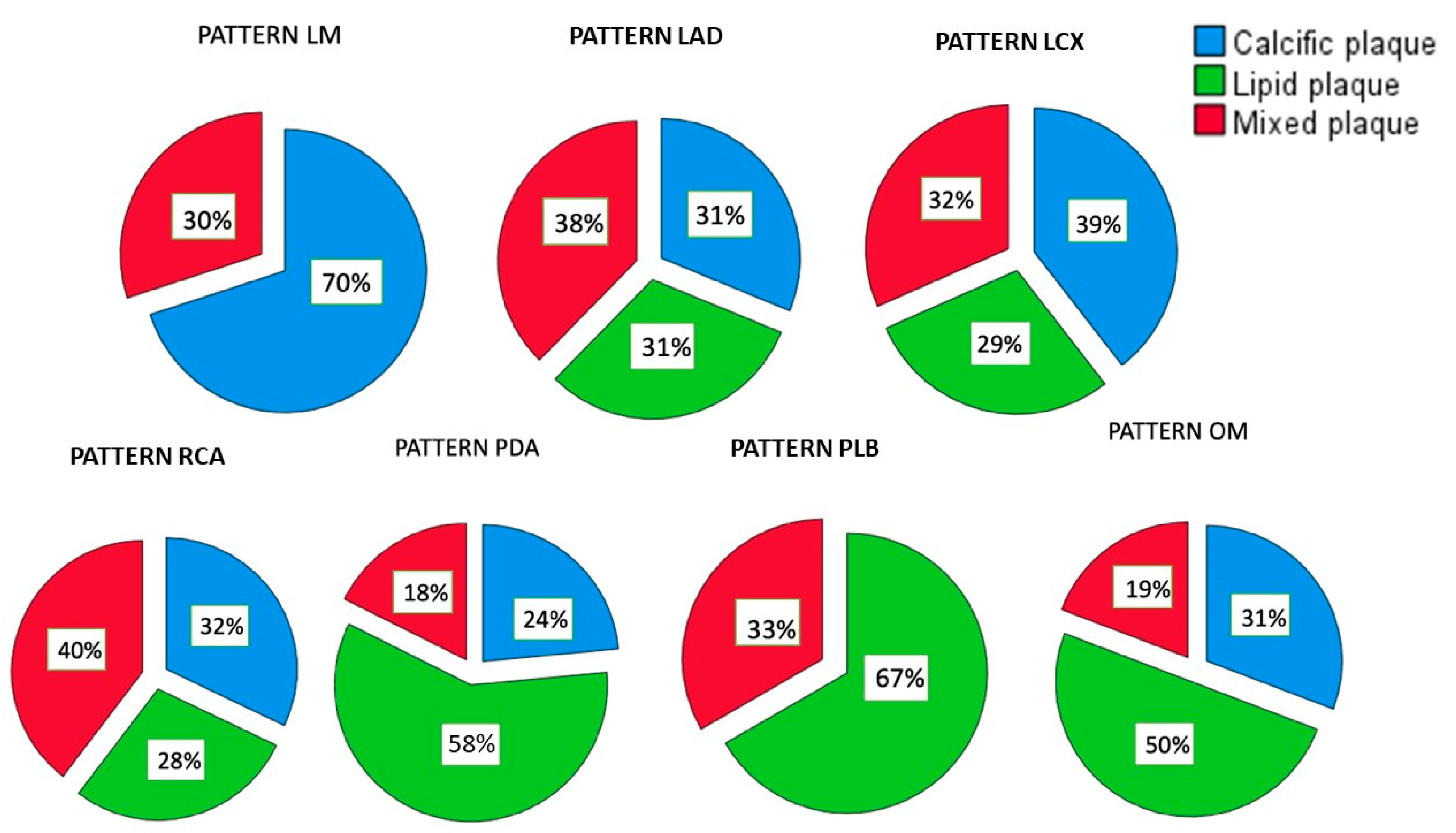
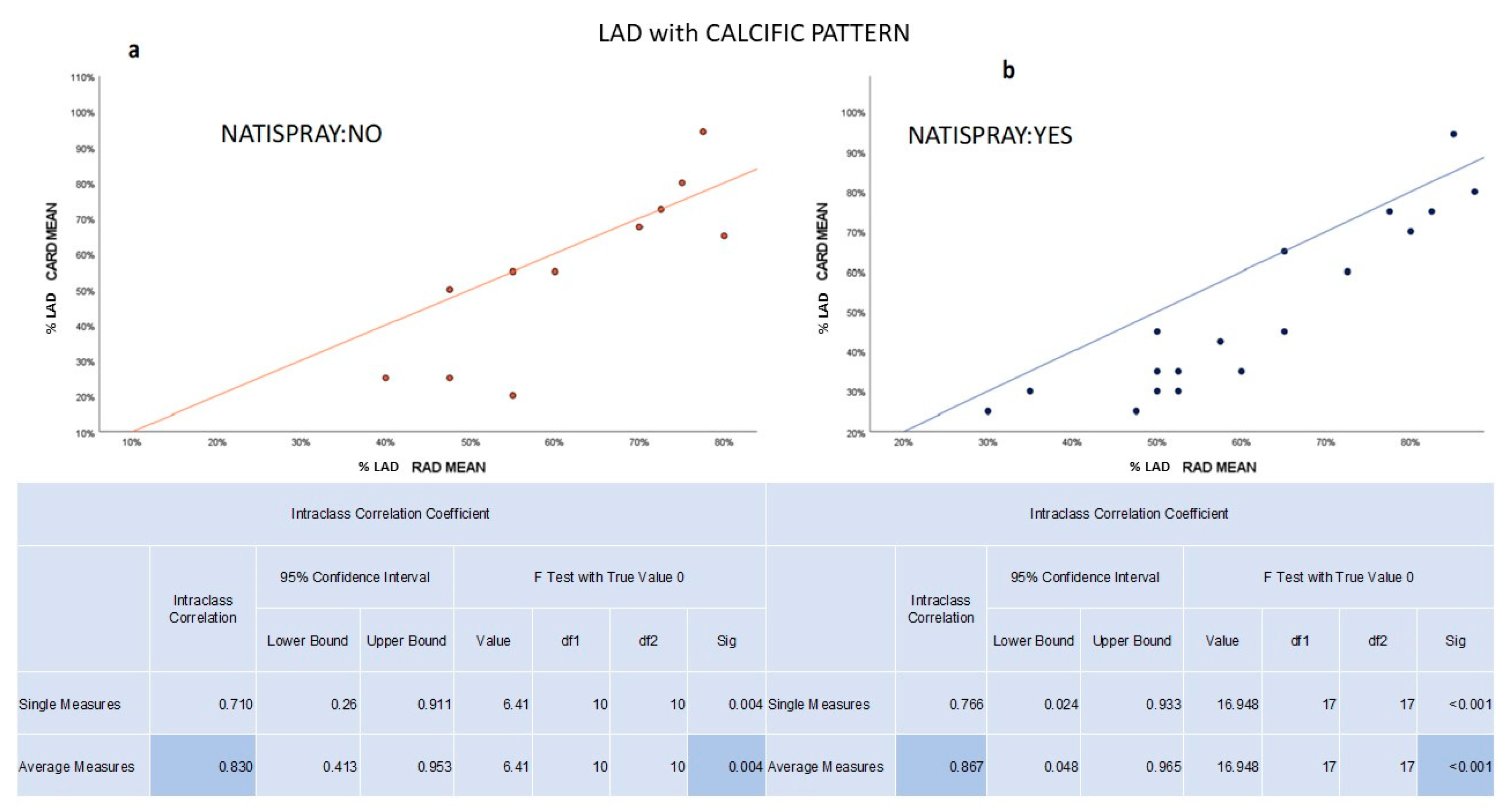
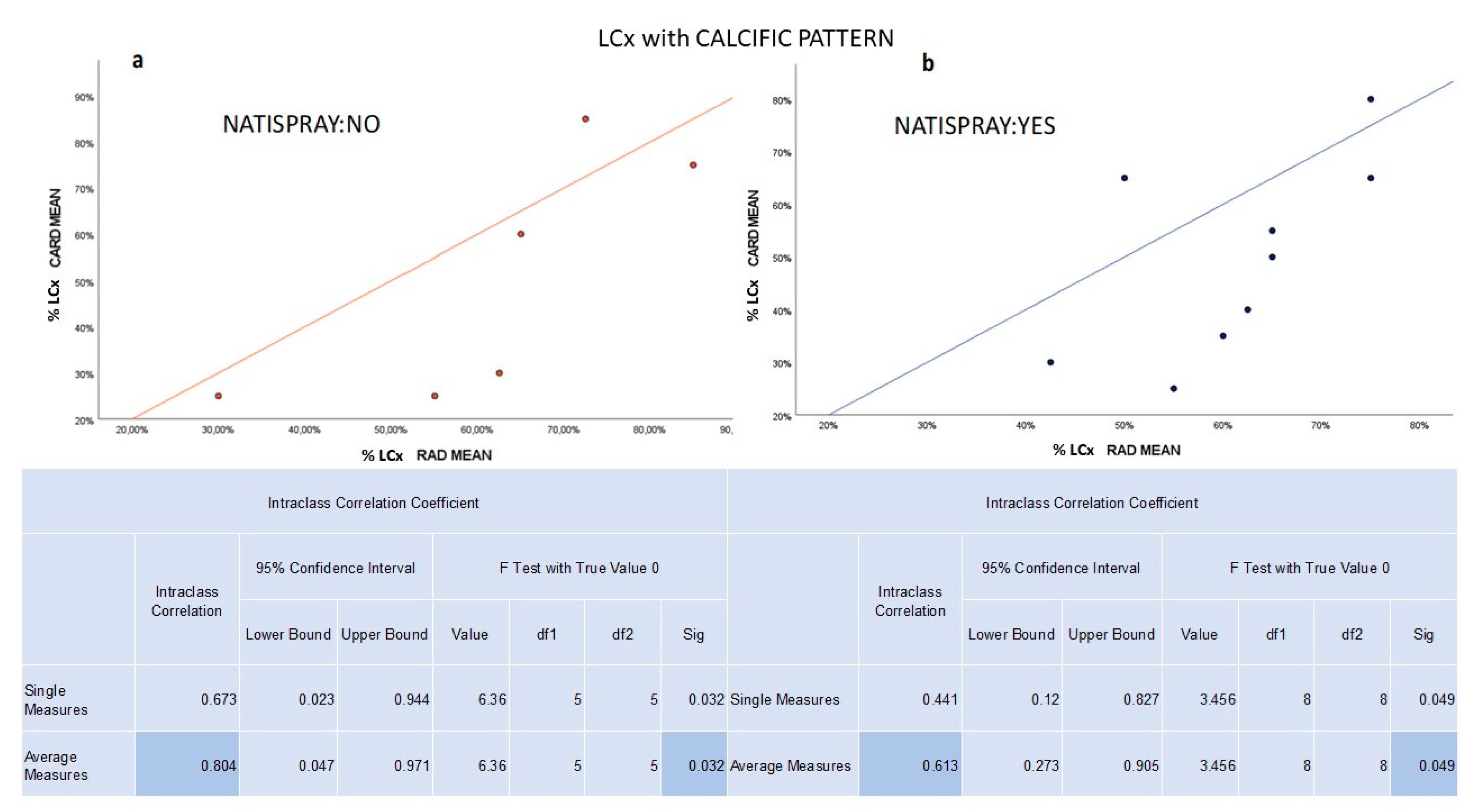
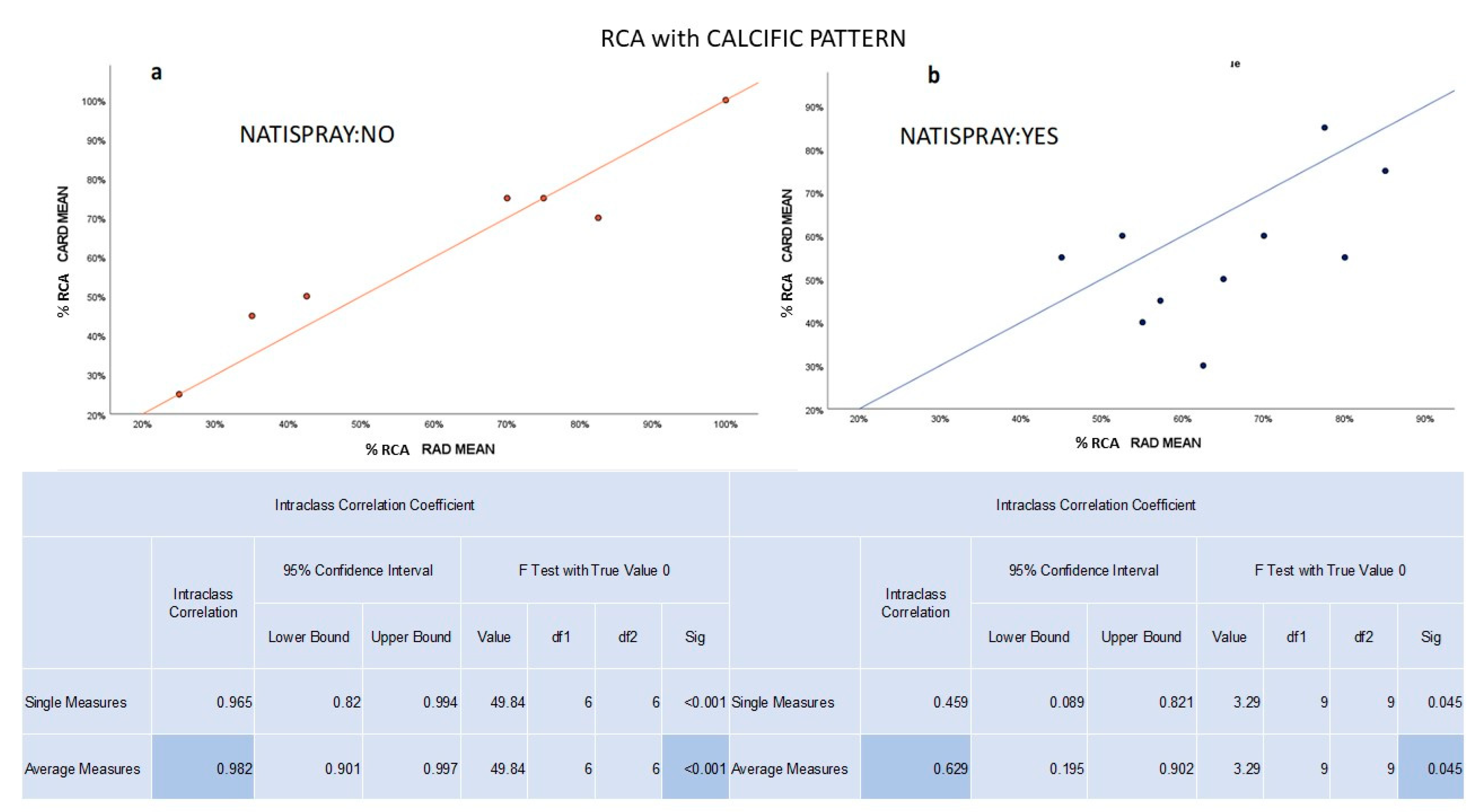
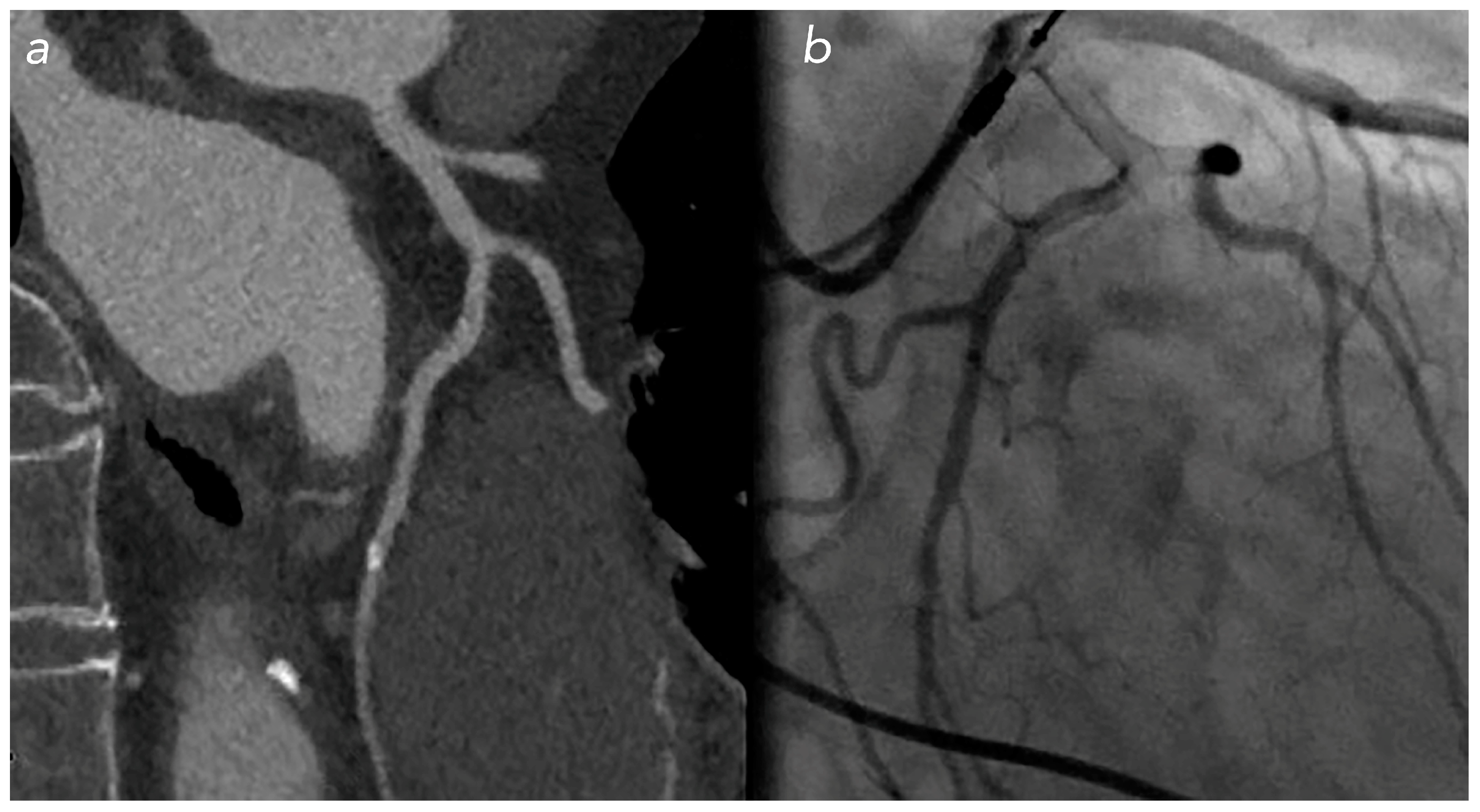
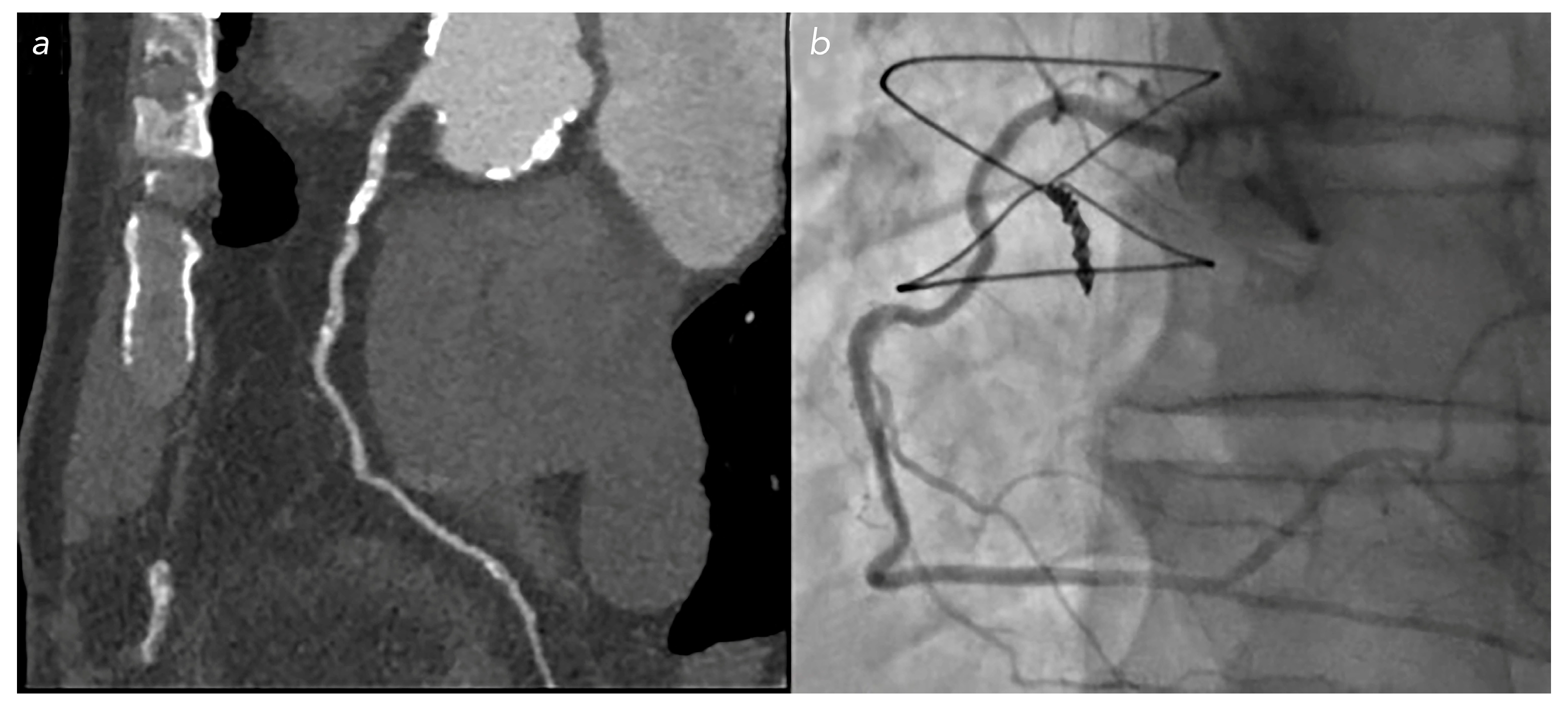
| Patient Characteristics | NTG Group | Non-NTG Group | Global Population |
|---|---|---|---|
| Nr | 70 | 61 | 131 |
| Female (%) | 18 | 14 | 32 (24.4%) |
| Male (%) | 52 | 47 | 99 (75.6%) |
| Age Mean ± SD | 71.05 ± 9.21 | 71.45 ± 9.73 | 71.24 ± 9.42 |
| Age Median | 72.5 | 73 | 73 |
| Age Min | 48 | 45 | 45 |
| Age Max | 90 | 87 | 90 |
| BMI Avg | 28.03 | 27.71 | 27.80 |
| HR Avg | 70 | 68 | 67 |
Disclaimer/Publisher’s Note: The statements, opinions and data contained in all publications are solely those of the individual author(s) and contributor(s) and not of MDPI and/or the editor(s). MDPI and/or the editor(s) disclaim responsibility for any injury to people or property resulting from any ideas, methods, instructions or products referred to in the content. |
© 2023 by the authors. Licensee MDPI, Basel, Switzerland. This article is an open access article distributed under the terms and conditions of the Creative Commons Attribution (CC BY) license (https://creativecommons.org/licenses/by/4.0/).
Share and Cite
D’Errico, F.; Ricci, F.; Luciano, A.; Sbordone, F.P.; Laudazi, M.; Mecchia, D.; Volpe, M.; Briganti, F.; Di Landro, A.; Muscoli, S.; et al. The Impact of Nitroglycerin on the Evaluation of Coronary Stenosis in Coronary-CT: Preliminary Study in 131 Patients. J. Clin. Med. 2023, 12, 5296. https://doi.org/10.3390/jcm12165296
D’Errico F, Ricci F, Luciano A, Sbordone FP, Laudazi M, Mecchia D, Volpe M, Briganti F, Di Landro A, Muscoli S, et al. The Impact of Nitroglycerin on the Evaluation of Coronary Stenosis in Coronary-CT: Preliminary Study in 131 Patients. Journal of Clinical Medicine. 2023; 12(16):5296. https://doi.org/10.3390/jcm12165296
Chicago/Turabian StyleD’Errico, Francesca, Francesca Ricci, Alessandra Luciano, Francesco Paolo Sbordone, Mario Laudazi, Daniele Mecchia, Maria Volpe, Flavia Briganti, Alessio Di Landro, Saverio Muscoli, and et al. 2023. "The Impact of Nitroglycerin on the Evaluation of Coronary Stenosis in Coronary-CT: Preliminary Study in 131 Patients" Journal of Clinical Medicine 12, no. 16: 5296. https://doi.org/10.3390/jcm12165296
APA StyleD’Errico, F., Ricci, F., Luciano, A., Sbordone, F. P., Laudazi, M., Mecchia, D., Volpe, M., Briganti, F., Di Landro, A., Muscoli, S., Pugliese, L., De Stasio, V., Di Donna, C., Romeo, F., Garaci, F., Floris, R., & Chiocchi, M. (2023). The Impact of Nitroglycerin on the Evaluation of Coronary Stenosis in Coronary-CT: Preliminary Study in 131 Patients. Journal of Clinical Medicine, 12(16), 5296. https://doi.org/10.3390/jcm12165296








